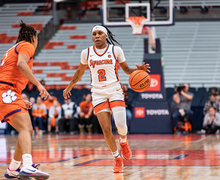Syracuse’s improved offense comes from net presence
Ally Walsh | Staff Photographer
Syracuse's offense lit up Lindenwood this weekend.
UPDATED: Monday Feb. 25, 2019 at 1:04 p.m.
Put the puck on net. Get to the dirty areas. Fight for rebounds. Syracuse head coach Paul Flanagan and his players have preached those things since the beginning of the season. In nonconference play, the Orange struggled to execute. They rarely spent extended time in the offensive zone, and when they were able to set up in the attacking third of the ice, they couldn’t create what Flanagan called, “Grade A chances.”
This past weekend, Syracuse (10-19-3, 10-6-2 College Hockey America) scored 10 goals in two wins against Lindenwood. It was a convincing sign of the strides the Orange offense has made since winter break. Even in losses, SU has often outshot its opponent and ran into stellar goalies, like in a home-and-home against the Rochester Institute of Technology in which Syracuse fired 84 shots but scored just once. But as of last weekend, its shots are getting in the net.
“Sometimes you overthink it,” junior forward Anonda Hoppner said, “and don’t realize that all you have to do is get the puck to the net and generate chances.”
Syracuse netted five goals Saturday against Lindenwood. To open SU’s scoring, Kelli Rowswell handled the puck behind the Lions net after the Orange’s initial shot was blocked. Anticipating a short-side attempt from the SU junior, Lindenwood’s goalie, Sophie Wolf, dove. With the goalkeeper out of position, Rowswell wrapped around the cage and stuffed the puck home.
Another helpful bounce led to Syracuse’s second goal. Emma Polaski’s blocked shot fell to Victoria Klimek, who fired it with Wolf out of position. Abby Moloughney took a weak wrist shot from the top of the faceoff circle later in the game, and the goalie couldn’t get enough of her glove on the shot to keep it out.
Chances have opened up for the Orange because of better puck possession and improved transitions from defense to offense, Flanagan said. Early in the season, neutral-zone turnovers and off-target passes led to opportunities going back the other way with a player advantage. Making tape-to-tape passes has paid off in recent games. SU defenders have sprung wingers to carry pucks into the offensive zone with more room to work with.
“We’re looking for different options,” Jessica DiGirolamo said. “Coach always tells us you have this play here or this play here, it just depends. So keep your head up and find the right play.”

Anna Henderson | Digital Design Editor
Polaski took advantage of the improved passing in a 3-2 overtime win against Robert Morris on Jan. 18. Allie Munroe entered the zone alone and was forced to cut back, waiting for support. Polaski charged across the blue line, and Munroe hit her in stride. SU’s leading goal scorer “hammered it home” on a one-timer, she said.
When the support doesn’t come immediately, Orange players are able to hold the zone and set up their offense. Defenders such as DiGirolamo and Munroe tend to pinch at the blue line to hold the puck in the offensive zone. Once set up, Syracuse playmakers can be more active in searching for incisive passes.
Polaski sent a cross-ice saucer pass to DiGirolamo, who caught and fired a shot top-shelf in one motion Friday night against Lindenwood. Those types of plays have occurred increasingly in the last month.
“We look for each other out on the ice,” DiGirolamo said on her and Polaski. “I just feel like we have a lot of chemistry.”
Syracuse has beaten every CHA opponent except for RIT this season, and in most cases, it has happened due to offensive outbursts. The Orange have scored less than three goals only in two of their 10 conference wins. In three out of four games against RIT, SU averaged a goal a game.
In its most recent series against the Tigers, SU’s lack of scoring came with scoring chances. Syracuse’s season-high in shots (44) came in a 1-1 tie with RIT in the second game of a home-and-home. The night before, in Rochester, the Tigers’ goalie recorded a 40-save shutout.
In both games, Syracuse held the possession advantage as well as the shooting advantage. For the last five minutes of regulation at Tennity Ice Pavilion, the puck barely left the RIT defensive zone. Lauren Bellefontaine was denied on an easy chance close to the net, and then, on a power play, Brooke Avery hit the pipe, and the puck came down on the goal line before bouncing out of the crease. Syracuse still isn’t finishing all of its chances, but “the more shots you take, the more chances that you’re going to put it in,” Moloughney said.
“As long as you’re going in there being like, ‘You got to be desperate, I gotta play desperate,’ that means you’re going to work harder,” Moloughney said. “You’re going to work super, super hard because you just want to get the puck in the net.”
CORRECTION: The text in the first graphic was misstated. Syracuse scored two goals per game in its first 30 games, not four five-goal games. The Daily Orange regrets this error.
Published on February 25, 2019 at 12:09 am
Contact Arabdho: [email protected] | @aromajumder





